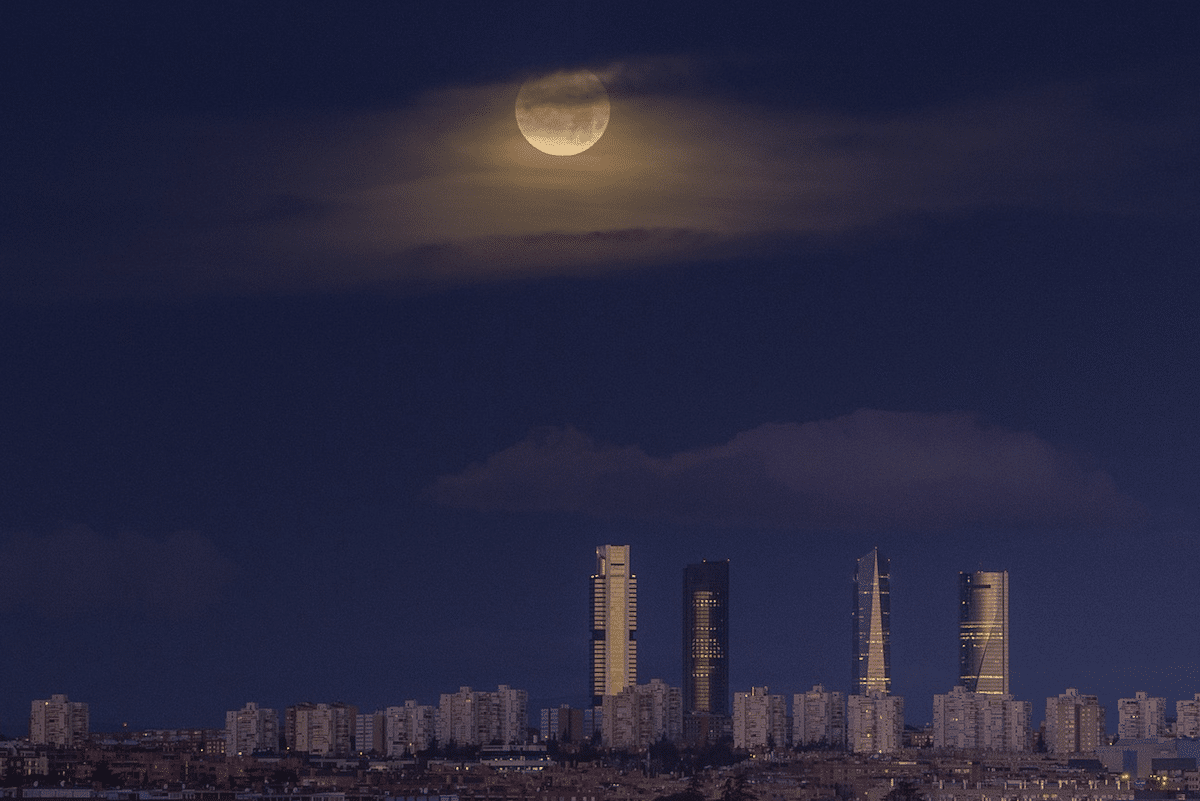
About 35% of light is wasted by unshielded or poorly aimed outdoor lighting. [Photo: Pixabay]
“It’s irresponsible to take a finite resource and use it in an illogical manner.”
When Pete Strasser joined the International Dark-Sky Association (IDA) in 2005, his background may have been in plant pathology—having become an expert in ornamentals and using light to coax blooming—but his passion for astronomy and photography also made him a good fit as IDA’s new technical director. “I understood light and its impact,” he says. “It’s been a fun ride ever since.”
Today Strasser keeps his finger on the pulse of the lighting industry, constantly monitoring how changes in lighting technologies affect the natural environment. “I look for win-win situations where people get the necessary lighting with the least amount of harm.”
The thing is, lighting—or light waste or skyglow (the artificial brightness of the night sky that’s caused by light pollution)—has become somewhat of an issue. “Ultimately our goal is to no longer be necessary,” Strasser says. “Ideally, our mission is the return of the nighttime sky to levels people haven’t seen for 100 years.” But as the nonprofit kicks off its 30th year, it looks beyond the stars to even more environmental concerns.

Pete Strasser of the International Dark-Sky Association talks light pollution. [Photo: Courtesy of Pete Strasser]
gb&d: When did light pollution become an issue?
Strasser: It’s hard to say. I have a turn-of-the-century woodcutting from a magazine or book that talks about how lighthouses can draw birds in and cause disruption. The problem has been noted as long as there’s been artificial light at night, but whether or not it’s been seen as something that warrants tremendous concern or control is an ongoing battle. People need to be made aware that you can have both proper lighting and minimal impact.
I live in Tucson, a municipality of more than a million people, and I can see the Milky Way from my driveway every night. Just because there are a lot of people doesn’t mean there has to be bad lighting practices that obscure the heavens and waste resources and money.
gb&d: How has light pollution changed?
Strasser: It’s increased. A recent German study found light pollution is rising at about 2% a year, even with efforts like IDA’s. It would have been worse if there hadn’t been regulations and ordinances put into place, but there are plenty of places on the planet where putting up bright lights is seen as an accomplishment.
gb&d: Wasting energy has huge economic and environmental consequences—why is this important to you?
Strasser: It’s irresponsible to take a finite resource and use it in an illogical manner. Any light, any energy not devoted to the task is waste. We try to become as efficient as possible. It simply hasn’t occurred to everyone yet that putting a circular lollipop on a pole and putting a bulb inside to light the streets—when half the energy and cost is not doing that—is silly. People think we have the luxury of waste or that it’s not an issue, but it’s fiscally irresponsible—let alone wrong—to waste.
gb&d: What’s the connection between light pollution and energy waste?
Strasser: You always have to fall back to the task: Lighting should be where you need it, when you need it, in the amount necessary, and no more. Having a light on in a parking lot all night when no one’s there—that’s waste. If you have a parking lot and people are there, but it’s five times brighter than necessary, that’s waste. The notion of where, when, and how always falls into play—and where comes into the design of light itself.
If you have an acorn-type fixture lighting a street, half of the energy consumed is shining upward, not going toward the task. Why spend half a streetlight bill doing something it’s not supposed to do? A streetlight should light the street, not the undersides of airplanes.
gb&d: Explain the connection between carbon emissions and light waste.
Strasser: It depends on the source. Anytime a fossil fuel is used to generate electricity to light a non-efficient product, you’re adding CO2 to the atmosphere for a nonsensical use. The Department of Energy says 15 million tons of CO2 are emitted each year in order to power residential outdoor lighting in the U.S. and about 35% of that is wasted as skyglow.
gb&d: How can we make a difference?
Strasser: Better design—make sure your light fixtures are actually going toward the task. Lighting levels—these should be reasonable, not excessive. Utilization of motion and occupancy sensors makes good sense—again, there’s no reason to have a light in an area when it’s not necessary. By incorporating these things, certainly there can be a significant amount of savings realized.
gb&d: Are LED lights the solution?
Strasser: There are good LEDs and bad LEDs. They are so much more efficient than previous sources, but when it comes to energy efficiency, they’re not the be-all and end-all. LEDs are cheaper to use, so people are using more of them. Now is the time, with this change in technology, to evaluate our lighting practices and see if we can, in fact, change.
In Tucson, for example, we reevaluated the area’s lighting plans and found we were overlighting our streets. We switched to LEDs, we are still meeting the recommended practices of the Illuminating Engineering Society, and we’re putting out only 40% of the light we did before—and no one’s noticed. Only about 5% of municipalities across the country even seek to meet these recommended levels, but if there’s actual design being done to specification, people are surprised they don’t need as much light as they thought they did.
gb&d: Is reducing light waste an attainable goal?
Strasser: There are a couple things to consider. For the last decade, twice every year during the bird migration period, St. Louis, Toronto, and Chicago have asked high-rises to identify and turn off lights that don’t need to be on at night. You can see pictures in newspapers of city lighting before the migration and during when the lights are out—but what they don’t show are the pictures two weeks later when the migration is done and everyone’s turned the lights back on. Why? It’s been identified that those lights could be turned off without any harm. IDA’s challenge is overcoming the inertia of the way things are done and of what people expect. If a person expects to see blinding light in order to feel safe, overcoming that can be impossible.
People also have the notion that if they don’t see the light source, if they don’t see glare, then it’s not bright enough or it must not be safe, when in fact that kind of glare can make an unsafe situation. Everyone’s heard the phrase “lurking in the shadows.” Glaring conditions create the shadows in which people can lurk, so more lighting isn’t always safe. Better lighting is safe.
We have to change things over time. There’s a small city in Canada, near the Mont-Mégantic Observatory, called Notre-Dame-des-Bois that had one street with a bunch of 175-watt lights. On the same day, the city changed all of the bulbs to 70 watts and no one even realized the intensity had been cut by half. The same thing happened in Tucson; people just didn’t notice. If change is experienced all at once, people don’t recognize it as a problem.
gb&d: Are we afraid of the dark?
Strasser: Absolutely. Light is a sign of prosperity. One of the strangest examples I’ve ever heard: There’s this picture of the world at night from space and the brightest spot on there is Belgium. I visited there and every square-inch is illuminated. I asked people why and they said: “Because we won.” We won what, I’d ask. “World War Two.” We’re talking 70 years ago, it was important to them that, when the Nazis left, they could turn the lights back on—and that’s the way they do things. How do you overcome something like that? It takes generations of saying, “Maybe we don’t need to be so excessive.”
You can have a well-lighted place that’s not dark but that’s also without any light pollution. It just takes the skill of a lighting designer—one of the least utilized experts in the field, they’re half engineer and half artist. They’re very careful with where they place lights—you know it’s going to be well done and certainly won’t pollute as much as someone putting in a lowest-bid installation of floodlights. Yet, what’s the most common thing we see? Lowest-bid installations. Not everyone recognizes that worthwhile upfront costs can save money in operations and get you a much better looking building.
gb&d: Why is poor lighting so ubiquitous? Were we not aware of the consequences of light waste in the beginning?
Strasser: That has a lot to do with it—no one set about to cause lack of visibility of the stars. It just happened. If you go for lowest-bid lighting, it’s going to be cheap and uncontrolled. And if you’re going for a lowest-bid manufacturing protocol, that’s just one of the problems LEED and green builders face—the construction paradigm that if you’re not going to benefit operationally, then why make it expensive in the beginning. That stands for a lot of lighting practices as well.
Lighting is often seen as a last, unnecessary detail left up to an electrical contractor who slaps it up and calls it done, as opposed to a lighting designer who actually takes time to put in a good looking installation that will perform very well. The minimal upfront cost of poorly designed lighting fixtures is a significant problem. IDA is about good lighting and good design—with that, the problem would solve itself.
BY THE NUMBERS: What is light pollution costing us?
- About 35% of light is wasted by unshielded and/or poorly aimed outdoor lighting. This is about $3 billion per year worth of energy lost to skyglow (the artificial brightness of the night sky that’s caused by light pollution), which is about $10 spent for every man, woman, and child in the U.S. every year.
- 13% of residential electricity use in the U.S. is for outdoor lighting. The average house’s bad outdoor lighting wastes 0.5 kilowatt-hours (kWh) of energy per house per night. 0.5 kWh of electricity = enough energy to power a 50-inch plasma TV for 1 hour.
- About 15 million tons of CO2 are emitted each year in order to power residential outdoor lighting in the U.S. About 3 million passenger cars have the same CO2 emission rate, which is 40,000 tons per day. About 600 million trees would need to be planted to offset that amount of carbon emission.
*Sourced from U.S. Department of Energy 2011 data
